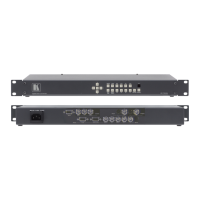41
9 RS232 PORT
9.1 Connection
Your unit is fitted with a standard ‘D9’ socket allowing it to be controlled from a
computer or other type of terminal or console with a similar interface. Most
computers fitted with an RS232 port, known as a ‘COM’ port, will have a ‘D9’ plug
on them. To enable connection between the two devices you may require a D9
male to female cable to link from the computer to your unit. This cable is not the
same as a ‘null-modem’ cable as this has a female socket connector on both ends.
See the Specifications section for a detailed pin connection list.
Should your PC not have an RS232/COM port, it is possible to add an interface
card into the PC to add this facility. Another option you could use is a USB to
RS232 converter. Both methods will add a COM port to your PC, although you
should be aware that these generally do not default to being ‘COM1’ which is the
default most RS232 applications will use.
The default baud rate is 57600 with 8 data bits, 1 stop bit and no parity. This baud
rate can be changed in the System menu to suit other programs if need be.
9.2 Communications protocol
The standard communications protocol for your unit is text-based and is detailed on
our website. Also on our website, you can find the Windows Control Panel for your
unit.
The protocol is also bi-directional (unit and computer both send messages to each
other), so that you can send changes to the unit, and it will also respond with any
changes made via alternate methods (front panel buttons, menu changes and infra-
red control). This enables any attached computer to be aware of any changes
made to the unit from an alternative source rather than itself.
What this means is that you can easily find out the exact command to send to the
unit to tell it to perform a certain function. This can be seen by the data that is sent
back to the computer when changing values on the unit. For instance, just by
turning FREEZE on, by pressing the FREEZE button, will cause RS232 data to be
sent to the computer that represents the command required to set FREEZE on. A
second press, to turn FREEZE off, then sends the computer the command required
to turn the FREEZE off.
Note: Any command you send to the unit will be replied to either with an error code
or with the actual changed value. This may be different to the one you sent; for
example, if trying to set a value too high or too low.

